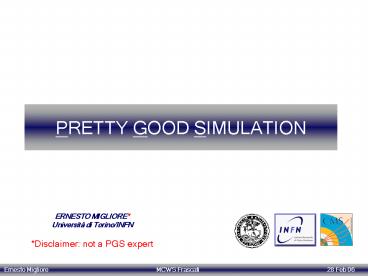PRETTY GOOD SIMULATION - PowerPoint PPT Presentation
Title:
PRETTY GOOD SIMULATION
Description:
PRETTY GOOD SIMULATION ERNESTO MIGLIORE* Universit di Torino/INFN *Disclaimer: not a PGS expert c |---- pgs_next_event ... c | c |---- tauola ... – PowerPoint PPT presentation
Number of Views:22
Avg rating:3.0/5.0
Title: PRETTY GOOD SIMULATION
1
PRETTY GOOD SIMULATION
- ERNESTO MIGLIORE
- Università di Torino/INFN
- Disclaimer not a PGS expert
2
- Fortran library (former SHW) by John Conway
Higgs/SUSY Tevatron RUN II - http//www.physics.ucdavis.edu/conway/research/so
ftware/pgs/pgs.html
- native interafce to PYTHIA and ISAJET
- interface to user events through STDHEP
- Note hadrons to be supplied by the user
- c ----gt pgs_next_event
- ...
- c
- c ----gt tauola_scan
- ...
- c
- c ----gt pgs_trigger
- ...
- c
- c ----gt pgs_recon
- ...
- c
- c ----gt pgs_user_analysis
- c ---gt pgs_write_event
? decays polarization
Event loop
Detector Simulation
Output of selected events through STDHEP
interfaces to HBOOK routines
3
PROCESSING OF EVENTS
- pgs_trigger
- ---gt pgs_find_tracks make track list
- ---gt pgs_fill_cal calorimeter energy array
- ---gt pgs_find_clusters calorimeter energy
clusters - ---gt pgs_find_TTT_trig
- pgs_recon
- ---gt pgs_find_RRR
- From ISTHEP and PHEP
- Smearing of pT, EEM and EHAD
Fixed size cone ?R
TTT ?/e, ?, ?, jet, MET
RRR ?/e, ?, ?, jet, b, c
- Analysis of reconstructed objects on events
selected on the basis of trigger objects
4
SIMULATION OF THE DETECTOR
- main detector effects
- pT smearing
- EEM, EHAD smearing
- Energy deposited in towers (granularity of HCAL)
- Tag efficiency (?-ID, ?-tagging, b/c-tagging)
- Detector parameters partly from cards partly
hard-coded
5
LHC_DETECTOR_PARAMETERS
- LHC ! parameter set name
- 81 ! eta cells in calorimeter
- 63 ! phi cells in calorimeter
- 0.1 ! eta width of calorimeter
cells - 0.099733101 ! phi width of calorimeter
cells - 0.1 ! electromagnetic calorimeter
resolution sqrt(E) - 0.8 ! hadronic calorimeter
resolution sqrt(E) - 0.2 ! MET resolution
- 0.00 ! calorimeter cell edge crack
fraction - 3.0 ! calorimeter cluster finding
seed threshold (GeV) - 0.5 ! calorimeter cluster finding
shoulder threshold (GeV) - 0.70 ! calorimeter cluster finder
cone size (delta R) - 1.0 ! outer radius of tracker (m)
- 2.0 ! magnetic field (T)
- 0.000005 ! sagitta resolution (m)
- 0.98 ! track finding efficiency
- 0.30 ! minimum track pt (GeV/c)
- 2.0 ! tracking eta coverage
Calorimeter?HCAL
5 ?m? ?pT/pT4x10-5 pT (GeV)
6
CALORIMETRY
- Hard-coded
- single pion energy
- 100 HAD 50 times
- 25 EM 75 HAD 50 times
- EM cluster definition EHAD/EEMlt12.5
(?0) CDF ATLAS CMS
EM PbSci PbLAr PbWO4
EM 19 X0 24 X0 26 X0
EM 1 ?I 1.2 ?I 1.1 ?I
HAD FeSci FeSci CuSci
HAD 4.5 ?I 7.2 ?I 5 ?I
7
b-TAGGING
Track counting (N3)
?q jet q tagged as b / jets q
Hard-coded
CMS
PGS
LHCO
?0
v3.3
C.Weiser FNAL 18Jan06
uds gluons c
eff(b)50
8
SIMULATION OF THE DETECTOR
- main detector effects
- pT smearing
- EEM, EHAD smearing
- Energy deposited in towers (granularity of HCAL)
- Tag efficiency (?-ID, ?-tagging, b/c-tagging)
- Detector parameters partly from cards partly
hard-coded - Not included
- B deflection of charged tracks (effects on the
jet broadness) - pile-up (relevant for high luminosity analyses)
- underlying event (depending on the MC)
- background processes
9
OUTLOOK/DISCUSSION
- PGS validation/tuning
- vs. ATLAS and CMS fast simulation?
- vs. ATLAS and CMS full simulation?
- atlas.par, cms.par, lhcdet.par?
- Which observable in which process (which MC)?
- m(ll) in Z (jets)
- MET in W (jets) or tt
- (isolated ?)
- Size of the cross-section you want to investigate
(nb/pb/fb)

